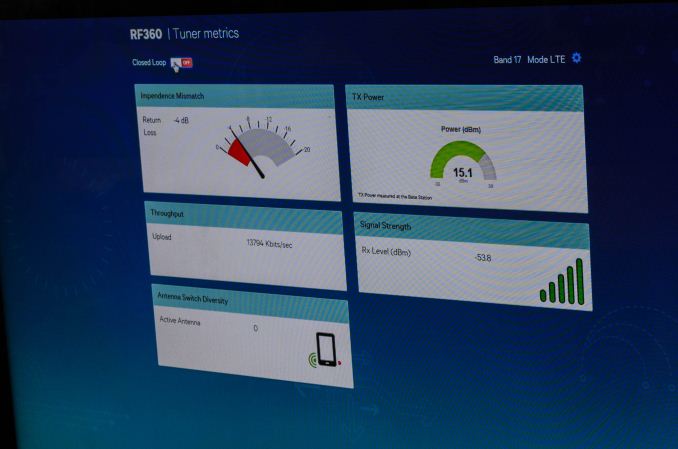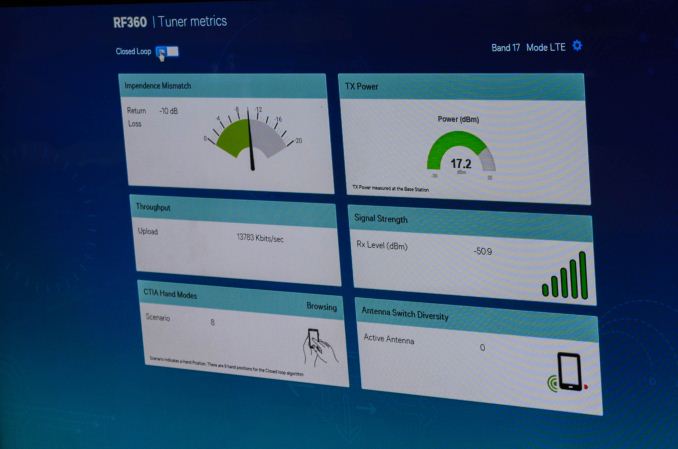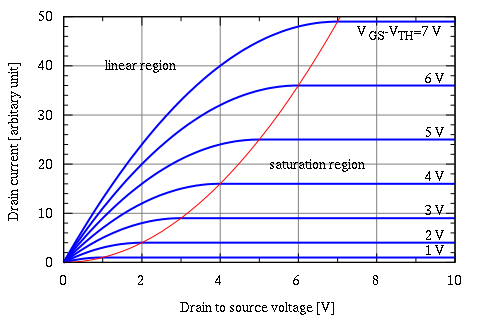Understanding Qualcomm's Snapdragon 810: Performance Preview
by Joshua Ho & Andrei Frumusanu on February 12, 2015 9:00 AM EST- Posted in
- SoCs
- Qualcomm
- Mobile
- Gobi
- Snapdragon 810
QFE2550 Antenna Tuner
One of the first areas to explore would be the RF front end, and before we jump into deep discussions we’ll tackle some of the simpler sections first. The QFE25xx antenna tuner is similar to the envelope tracker in the sense that it’s normally not part of the RF front end. I never actually mentioned an envelope tracker or antenna tuner at any step in the introduction. This is because these parts are not part of the basic superheterodyne radio system. However, like envelope tracking, the need for more battery life, faster data, and superior reception has driven the development of new technologies.
To understand how this antenna tuner works, we must introduce the concept of impedance matching and impedance. Impedance seems difficult at first, but is really just a form of resistance in an AC circuit for the purposes of understanding this article. The three components in a circuit that affect impedance are resistors, capacitors, and inductors. Impedance matching is exactly what it sounds like, which is equalizing the impedance at a junction. In transferring energy from an antenna to the RF front end, we must match the impedance between the antenna and front end. This is because if the impedances are mismatched, signal reflects back to the source. In other words, on the receiving side reception becomes weaker if impedance is mismatched, and on the transmission side energy is wasted. One can liken this to a glossy display, as while the vast majority of the light goes through the glass cover, some light is reflected back.
Of course, in the factory the RF system is carefully tuned to ensure that impedance mismatch is as low as possible. However, the real world makes for a difficult situation. The iPhone 4’s death grip behavior is a classic example of how real-world use can disrupt this impedance matching. By bridging two gaps in the metal ring of the iPhone 4, the antenna was detuned and its impedance was altered. As a result, signal became noticeably worse. Combined with the compressed signal representation, this made it possible for a “decent signal” to be completely lost by touching the right place on the phone.
This is where the QFE2550 antenna tuner and similar systems come in. By acting as a voltage-controlled variable capacitor, the baseband can be loaded with information that allows it to predict how much mismatch correction is needed for each detected scenario, which is accomplished with various sensors that can include capacitive touch sensors. Each situation is compensated for by using pre-loaded corrections that are loaded when a given scenario is detected based on frequency change or body loading scenarios. As a result, the efficiency of the antenna is restored as seen in the photo above, although the presence of body loading will inevitably reduce peak power and sensitivity. Such a system can be combined with more information, such as capacitive touch sensors or reflected power measurements to ensure maximum responsiveness and performance. This has the greatest benefit in enabling phones with all-metal unibodies, although other tools such as antenna switched diversity and MIMO can be used to ensure peak reception.
QFE33xx CMOS PA/Switch
Normally, power amplifiers are not worth talking about. However, with the introduction of RF360 Qualcomm has bandied about the concept of a CMOS PA to cover a wide swath of bands rather than just a few. While this sounds interesting, there’s a great deal more nuance to this issue than simply band coverage. First, semiconductor/solid state physics is required to really understand where the debate lies. Of course, there’s really no time to go over this in major depth, but there are a few basics. The transistor is a switch that controls the flow of current. However, there is a limit to how much current can be carried, and there are a few regions in which the relationship between voltage and current differ. The two that we’ll talk about are the linear region and saturation region. The linear region is exactly what it sounds like. Voltage and current are linearly related, following Ohm’s law. The saturation region is where this falls apart, and more voltage is needed to increase current by the same amount, and we see diminishing returns until maximum current is reached.
"IvsV mosfet" by User:CyrilB. Licensed under CC BY-SA 3.0 via Wikimedia Commons
So this is where we see a fundamental difference in the implementation of a CMOS PA and GaAs PA. Gallium arsenide has higher electron mobility, even in saturation mode. This makes it easier for GaAs circuits to switch at incredibly high frequencies such as 60 GHz for WiGig/802.11ad. In addition, unlike silicon-based transistors, gallium arsenide transistors are generally heat-insensitive, and pure GaAs has high resistance and dielectric constant, which means that it serves as an excellent substrate for various components for the same reasons that silicon-on-insulator (SOI) is a good substrate for CMOS logic. In addition, GaAs-based transistors are highly linear in behavior when compared to CMOS technologies, so a GaAs PA can operate much closer to maximum current without clipping the signal.
However, GaAs is not perfect. For one, CMOS logic is impossible to implement using current technologies. This is because unlike current CMOS technology where there are NMOS and PMOS transistors, GaAs-based transistors do not have a p-channel equivalent. As a result, the controls available over a GaAs PA are significantly cruder than what is possible with a CMOS PA. GaAs PAs are also noticeably less efficient at low power levels, also known as the backoff condition. Therefore, CMOS PAs tend to be more power efficient at lower power states as they can have multiple “maximum power states” to scale the PA as needed. In practice, Qualcomm claims that we’re still looking at around a 5-10% efficiency delta at max power when compared to GaAs PAs, which means that CMOS PAs are close to GaAs PAs in efficiency.
Despite the differences in efficiency, a CMOS PA is still a valid option in smartphones due to the fact that a single PA can cover far more bands than an equivalent GaAs PA, as the PAE curve across a spread of frequencies is relatively flat compared to a GaAs PA which is effectively a single peak. In addition, the fact that the PA is built on CMOS means that there is additional integration capability. In its current incarnation, the QFE33xx already has an integrated antenna switch, and there is potential for greater integration with parts that share a similar process node.
This concludes RF360, which gives a broad survey of what’s on the market today. Combined with our previous piece on MDM9x25, it’s possible to get a good idea of the current state of the market. However, the latest and greatest modems and transceivers mean that it’s time to talk about UE category 6, 9, and 10 LTE and the various challenges that come with new capabilities.














119 Comments
View All Comments
warreo - Wednesday, February 18, 2015 - link
HAHAHA Tchamber you are a jewel. Thanks for making my morning. Here I was wondering if a week later anybody else had anything intelligent to say....Your analogy of the 5433 as a Lamborghini and the Snapdragons as Corvette/Camaro/GT500 is horrible. Period. Anybody who reads this site should know that. If you really want to get into an argument with someone, you should actually know what you're talking about before insulting them.
As for me, I wasn't talking to down to anyone. I gave AT my observations and also did in fact summarize my own conclusions if you'd bothered to read my comments in totality. Just because I disagree with them doesn't mean I'm talking down to them. You, however, should run along back to pre-school and learn how not to be a prick to others.
djvita - Thursday, February 12, 2015 - link
found some typoslast paragraph GPU performance "Qualcomm has narrowedmuch"
CPU performance
PNG Comp ST 0.82 MP/s 1110 MP/s 1.11 MP/s 35%
is 1110 correct? found the difference to be very high....
All in all, preliminar benchamrks looks good. Seems anandtech will need a flex2/mi note pro or the upcoming htc m9 in MWC (for sony no rumors, until july i think, lg g4 maybe in may. S6 wont be qualcomm)
Ratman6161 - Thursday, February 12, 2015 - link
Another typo:There are three tables at the top of the CPU Performance page. The last column in the first table says: Snapdragon % Advantage which clearly isn't correct because just in the first line the Samsung has about a 2 to one advantage it says the snapdragon advantage is 608%. I assume you actually meant this column to say but S810 > S805 % Advantage like in the second two tables.
djvita - Thursday, February 12, 2015 - link
they fixed them all now, it was 1.11SydneyBlue120d - Thursday, February 12, 2015 - link
Very interesting article. Do you think it is possibile the Galaxy S6 devices will use the MDM9x45 modem?deathBOB - Thursday, February 12, 2015 - link
Subjective impressions? Andrei pointed out that the Exynos was subjectively faster than the 805. How does the 810 fare?MrCommunistGen - Thursday, February 12, 2015 - link
Thanks for the informative article! The scope of the article as a whole goes far beyond a Preview of Snapdragon 810, specifically the sections on RF and Qualcomm's scheduler.That in mind, I'll hold off on passing judgement on S810's performance until we see shipping silicon. Between pre-release drivers and differences in chassis/thermals "Performance Preview" *is* spot on for the whole benchmarks section.
Even though S810 is Qualcomm's stopgap and there's only so much you can do (for better or worse) to the performance of off the shelf A57/A53 cores, I'm glad they're still in the game - or at least not out of it. Even as a preview, it is clear that Adreno 430's performance is more than just an iterative increase over Adreno 420.
Regardless of how S810 shakes out, I'm sure Qualcomm is baking all of their learnings from working on this SoC into their in-house ARMv8-A design
Mr.r9 - Thursday, February 12, 2015 - link
Even though this is a preview and drivers/Kernel will definitely improve....I still feel that the 810 will underwhelm.djvita - Thursday, February 12, 2015 - link
considering I still have an msm8960 device, this will be a huge jump for me.tviceman - Thursday, February 12, 2015 - link
This performance preview just reaffirms two of my beliefs.1) It's a shame that Nvidia couldn't get more products with Tegra K1 in it, seeing how K1 has been on the market for many months and generally outperforms the 805 (sometimes by a wide margin)
2) It's a shame that Tegra X1 will likely suffer the same limited release fate that Tegra K1 suffered, even if manufacturers were to downclock Tegra X1 to meet smaller TDP demands. X1, even if downclocked, will run circles around 805.